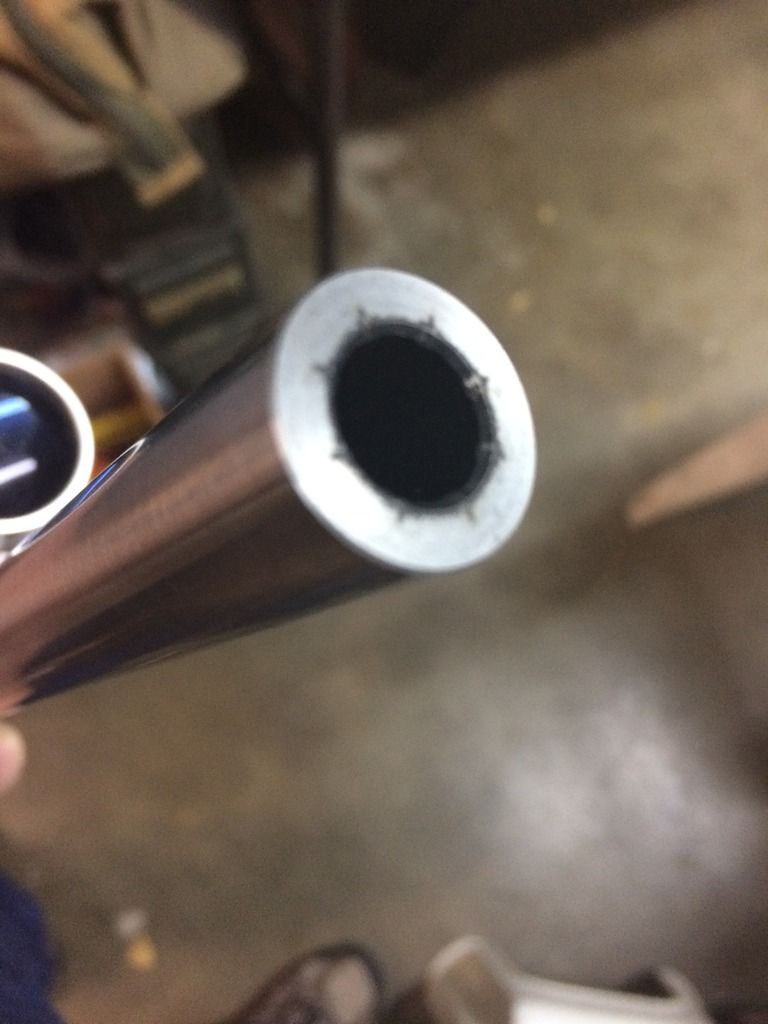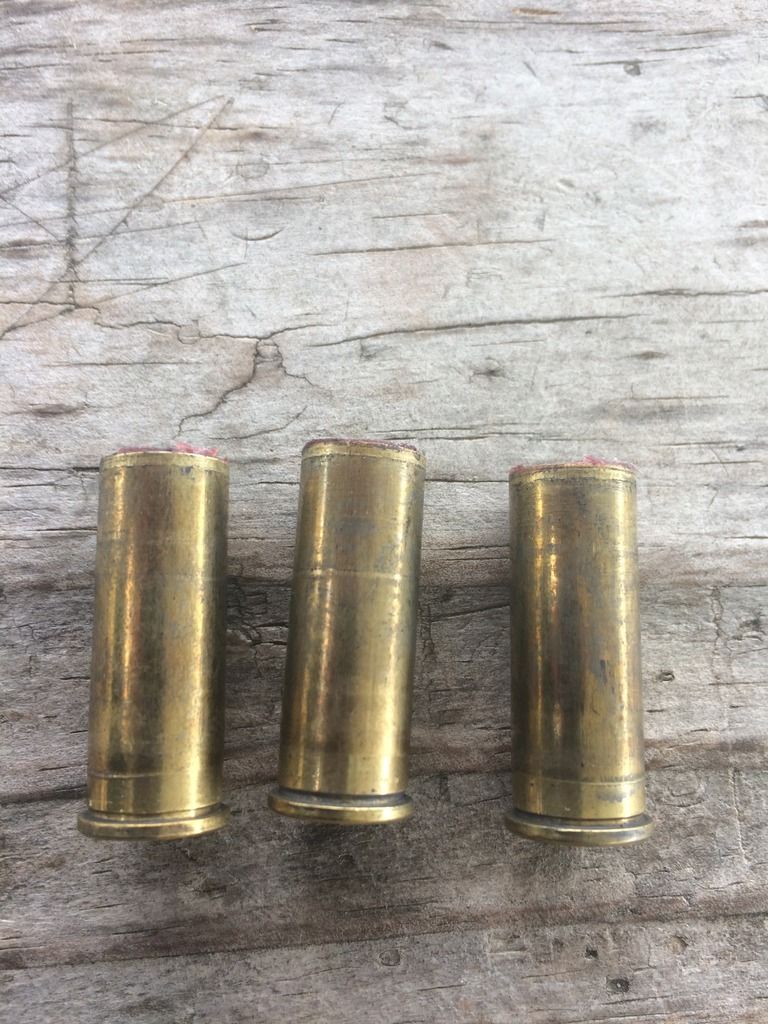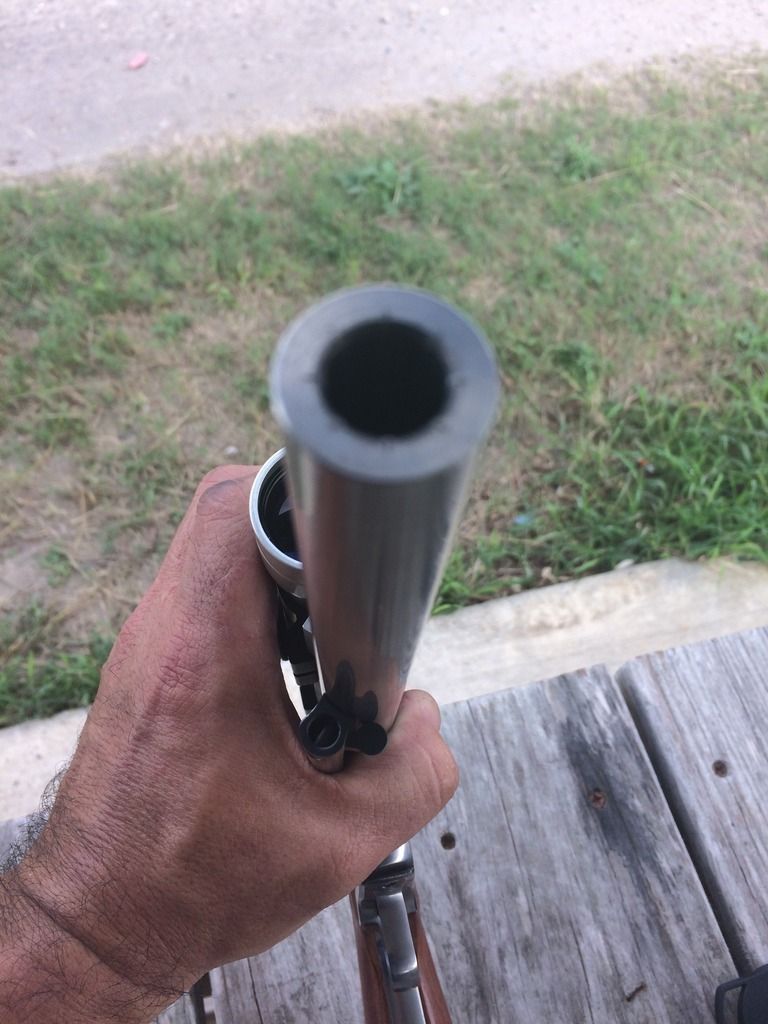|
|
Post by 2 Dogs on Dec 27, 2016 18:20:52 GMT -5
There are a lot of us on this forum who strongly urge guys to take up the art of bullet casting. Some of us talk about how much control we have over this or that and how rewarding the whole experience can be. Obviously we do our best to field questions when guys reach out to us on the forum as nobody understands how frustrated they can be as those of us who have been there and done that. Here, I am going to just point out a couple of things that I try to look out for and avoid at the same time. One of the things I am always telling the guys who still shoot traditional cast bullets with real bullet lube in the groove is to look at the muzzle of the sixgun. You should see a "star" of lubricant. This is very good. It tells you your bullet lube is making it all the way to the muzzle. Here is photo of the new custom Douglas barrel I installed on my .44 Magnum Bisley given to me by my buddy Jeff. I call it Hoover's Hammer. This is a good example of what you want to see.  |
|
|
|
Post by 2 Dogs on Dec 27, 2016 18:34:52 GMT -5
There are also some things you do NOT want to see. I have come across this a time or two especially since I have long changed my opinion about how hard a cast slug should be. I have come to the conclusion that I only want my bullet to be as hard as it needs to be. Can it be too soft? Yes, it certainly can. You might see this in the form of poor accuracy, poor penetration, and or barrel leading even if everything fits properly. So you might ask why that might be? Well, it could be as simple as your bore on your Smith might not be as smooth as the one on your Blackhawk even if they are both the same caliber. Yeah, that's right, the same ammo wont always perform well in different sixguns. So, I remind you yet again, do not load or cast a billion rounds before you get out there and test them. So here is an example: Case lubricant left on the mouth of the case. This is telling me my bullet is too soft! Said a different way, the bullet is upsetting so fast and violently that the bullet lube is getting left behind. To be specific here, this is a 12 BHN GCHP 429215 Miha bullet on 23.0 grains of 2400 and a CCI 350 primer. Velocity from the 10" barrel is likely well in excess of 1600 fps. That's gotta be tough on a bullet....  |
|
|
|
Post by 2 Dogs on Dec 27, 2016 18:42:47 GMT -5
As further evidence, note the dimished lube star on the muzzle in this photo taken on a different day than the other muzzle star photo. This is after I saw case lube on the fired case mouths. Another thing I am screaming and jumping up about all the time is to be a base pin puller. Do not go to the range without that equipment you need to pull your base pin and check the condition of the bore. Now, in this case, I did not have any leading HOWEVER this lack of leading was probably due to the fact the bullet wore a gas check. So while I probably could have gotten away with this situation in this case, it most certainly is not optimal. I normally will mix up a alloy depending on what it is I wanted to do. Just because I got away with a 10 BHN bullet in my 327 Federal and 32-20 sixgun at 1500 plus doesn't mean I can the same with the .44 bore. More, it may not even have anything to do with barrel smoothness from sixgun to sixgun! It just may be one of those things. So, my intention is add a bit Linotype to my mix to bump up my BHN a bit.  |
|
|
|
Post by 2 Dogs on Dec 27, 2016 18:45:33 GMT -5
I will update further in the thread on Hoovers Hammer. Thanks for looking, and don't suffer in silence if you are having an issue with your sixgun. I fully expect Dick Thompson to chime in here with his own thoughts. My other partner in crime Jeff Hoover is on vacation. It's highly likely he is in full "slacker" mode and not add his 2 cents...
|
|
cmh
.401 Bobcat
  
Posts: 3,745
|
Post by cmh on Dec 27, 2016 19:28:25 GMT -5
Thank you Fermin...... this will be beneficial to pilgrims such as myself 😊
|
|
|
|
Post by BigBore44 on Dec 27, 2016 19:38:15 GMT -5
Thread Bookmarked...
It's Always a good thing to have more knowledge.
Thank you, Fermin...
Ray
|
|
|
|
Post by 2 Dogs on Dec 27, 2016 19:52:39 GMT -5
Thanks boys. That's a lot better than, "here he goes again".
|
|
|
|
Post by DiamondD on Dec 27, 2016 20:45:01 GMT -5
Great idea for a thread. I have heard on many forums about the star of lube but this may be the first picture I have seen illustrating it.
|
|
jsh
.327 Meteor
 
Posts: 884
|
Post by jsh on Dec 27, 2016 21:24:27 GMT -5
|
|
|
|
Post by 2 Dogs on Dec 27, 2016 21:35:26 GMT -5
It's enough to give you a headache... |
|
Deleted
Deleted Member
Posts: 0
|
Post by Deleted on Dec 27, 2016 22:26:30 GMT -5
It makes my head hurt, and I've been online with these guys forever! Every time lube starts making sense to me something changes.
Fermin, you did one hell of a fine job explaining lube performance so far. Please keep it up.
|
|
|
|
Post by Rimfire69 on Dec 28, 2016 7:30:39 GMT -5
I have experianced the lube on the case mouth with full bore .44 mag before, and now answers, thanks.
|
|
|
|
Post by sheriff on Dec 28, 2016 10:17:59 GMT -5
Good info for the 'new' and a good reminder for the oldsters.
|
|
Fowler
.401 Bobcat
  
Posts: 3,670
|
Post by Fowler on Dec 28, 2016 15:55:32 GMT -5
Fermin and I have spoken of that lube on the case mouth issue before, My FA 475/480 would often have a whole bunch of lube on the mouth of the case, basically filling the void from the front of the case mouth through the back taper of the cylinder throats with mild loads 850ish fps. The bullets were properly sized for the throats and the alloy was 92-2-6 alloyed lead pretty hard at 16-18 generally speaking, the lube is LBT Blue Soft, a very good lube and there is always an obvious star on the muzzle. Counters what Fermin says but I noticed that the issue is more apparent in very warm weather, colder weather and stiffer loads seems to make the issue largely go away. Not saying Fermin's is incorrect but there is a whole lot of different things going on when a round goes off and we all need to pay attention to all of the details, and I dont know that what is true in one set of circumstances is always going to be correct for all details.
Now my inquiring mind thinks that we might take a given bullet and cast it as say 3 distinctly different hardnesses, load them all the same, and test what works best. Group size would really be the only important detail for this test. Down the road we may many to choose run a given bullet as a hollow point and thus desire a given performance for the bullet upon impact, we might give up some accuracy to get the desired end result as long as we are still talking reasonable hunting accuracy.
|
|
|
|
Post by 2 Dogs on Dec 28, 2016 16:00:41 GMT -5
Fermin and I have spoken of that lube on the case mouth issue before, My FA 475/480 would often have a whole bunch of lube on the mouth of the case, basically filling the void from the front of the case mouth through the back taper of the cylinder throats with mild loads 850ish fps. The bullets were properly sized for the throats and the alloy was 92-2-6 alloyed lead pretty hard at 16-18 generally speaking, the lube is LBT Blue Soft, a very good lube and there is always an obvious star on the muzzle. Counters what Fermin says but I noticed that the issue is more apparent in very warm weather, colder weather and stiffer loads seems to make the issue largely go away. Not saying Fermin's is incorrect but there is a whole lot of different things going on when a round goes off and we all need to pay attention to all of the details, and I dont know that what is true in one set of circumstances is always going to be correct for all details. Now my inquiring mind thinks that we might take a given bullet and cast it as say 3 distinctly different hardnesses, load them all the same, and test what works best. Group size would really be the only important detail for this test. Down the road we may many to choose run a given bullet as a hollow point and thus desire a given performance for the bullet upon impact, we might give up some accuracy to get the desired end result as long as we are still talking reasonable hunting accuracy. It is important to note here that the FA sometimes can have a "abrupt" transition from chamber to throat. So there is another variable to be looked at as well. |
|